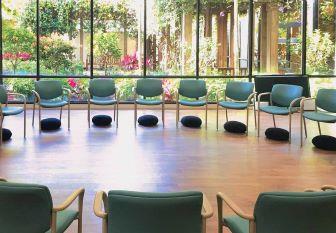Stroke Treatments & Services
Studies show that hospitals designated as Thrombectomy Capable Stroke Centers offer patients the best chance for survival and return to normal life. Stroke victims receive better treatment and recover with fewer disabilities. For instance, recommendations require round-the-clock neurosurgical staff and the latest technology to swiftly and accurately diagnose and treat acute stroke victims on an emergency basis. They offer access to advanced neuroradiological imaging and therapeutic techniques, which provides the widest range of interventional options to stop and minimize potential damage from a stroke.
Ischemic Stroke
Ischemic stroke happens when a clot blocks a vessel supplying blood to the brain. It's the most common type, accounting for 87% of all strokes. The treatment goal is to bust or remove the clot.
Treatment
Considered the gold standard, Tenecteplase is an FDA-approved treatment for ischemic strokes. When promptly administered, it can save lives and reduce the long-term effects of stroke. Many people miss this key brain-saving treatment because they don't arrive at the hospital in time, which is why it's so important to identify a stroke and seek treatment immediately for the best possible chance at a full recovery.
Thrombectomy
Physical removal of a large blood clot, called an endovascular procedure or a mechanical thrombectomy, is another strongly recommended treatment option. Thrombectomy allows trained doctors to use a wire-cage device called a stent retriever to remove a large blood clot. Thrombectomy should be done within six hours of onset of acute stroke symptoms. For selected patients under certain conditions, the procedure can be beneficial if done even within 24 hours of onset. Patients who are eligible for IV Tenecteplase should receive the drug, even if the clot removal procedure is considered. Patients must meet certain criteria to be eligible for this procedure.
Hemorrhagic Stroke
Hemorrhagic stroke is caused by a rupture in a blood vessel within the brain. Fewer strokes happen as the result of a rupture. The treatment goal is to stop the bleeding.
When a weakened blood vessel ruptures and spills blood into brain tissue, it’s called a hemorrhagic stroke. The most common cause for the rupture is uncontrolled hypertension (high blood pressure). There are two other types of weakened blood vessels that can also cause hemorrhagic stroke: aneurysms (swellings within vessels) and arteriovenous malformations or AVMs (abnormal tangles of blood vessels). Fewer strokes happen as the result of a rupture. The treatment goal is to stop the bleeding.
Treatment
A small tube called a catheter can sometimes be threaded up through a major artery in an arm or leg and guided into the brain tissue, allowing the surgeon to use camera technology to help fix the problem. Once the catheter is guided to the source of the bleeding, it deposits a mechanical agent, such as a coil, to prevent further rupture.
This type of procedure is endovascular, meaning that the surgeon gains access via the vascular system, making it less invasive than conventional surgical treatment. Sometimes surgery is required to secure a blood vessel at the base of the aneurysm.
Stroke Statistics
More and more people are surviving and thriving after acute stroke. Our goal is to provide patients the right level of care at the right time. We work closely with acute rehabilitation and skilled nursing centers to ensure treatment programs are tailored to best meet the needs of our patients.
To become a Joint Commission certified Thrombectomy-Capable Stroke Center, a program must meet ten core measures. These evidence-based measures are considered best practice and were developed under the guidance of the American Heart Association/American Stroke Association.
Patient Satisfaction
We take pride in assuring our patients have the best possible support while recovering from a stroke. Our goal is to help our patients understand:
- What caused their stroke
- How to prevent another stroke
- How to recognize the signs and symptoms of a stroke
- To seek immediate medical help if they think they may be having another stroke
Patient feedback is another important way that we measure our success. All stroke patients are enrolled in our "Healthy Planet Program." The patients are asked to complete a satisfaction survey, and we use this information to continually improve our care standards and patient services.
Patient Outcomes
On average 83-86% of our stroke patients are discharged home or to an acute rehabilitation facility.
In 2023, Jupiter Medical Center performed 29 Mechanical Thrombectomies with 0% complications.
In 2024, Jupiter Medical Center performed 20 Mechanical Thrombectomies with 0.05% complications.
-
Jupiter Medical Center
We want to help you! If you have questions about our services and what we can offer you and your loved ones, please reach out.
-
 October 21 Online: Mindful Movement View Event Details
October 21 Online: Mindful Movement View Event Details -
 October 21 Online: Mindful Movement View Event Details
October 21 Online: Mindful Movement View Event Details -
 October 21 Online: Mindful Movement View Event Details
October 21 Online: Mindful Movement View Event Details -
 October 21 Online: Mindful Movement View Event Details
October 21 Online: Mindful Movement View Event Details -
 October 21 Online: Mindful Movement View Event Details
October 21 Online: Mindful Movement View Event Details -
 October 21 Online: Mindful Movement View Event Details
October 21 Online: Mindful Movement View Event Details -
 October 16 Strategies for Better Brain Health to Age Well (in person) View Event Details
October 16 Strategies for Better Brain Health to Age Well (in person) View Event Details -
 October 16 Strategies for Better Brain Health to Age Well (in person) View Event Details
October 16 Strategies for Better Brain Health to Age Well (in person) View Event Details -
 October 16 Strategies for Better Brain Health to Age Well (in person) View Event Details
October 16 Strategies for Better Brain Health to Age Well (in person) View Event Details -
 October 16 Strategies for Better Brain Health to Age Well (in person) View Event Details
October 16 Strategies for Better Brain Health to Age Well (in person) View Event Details





